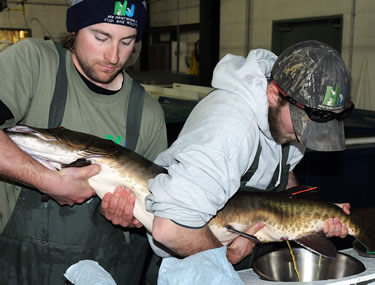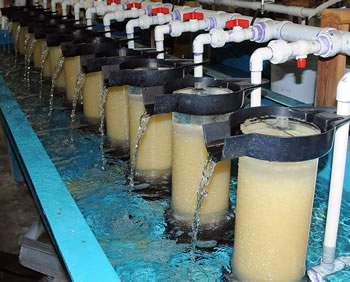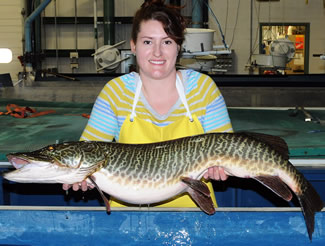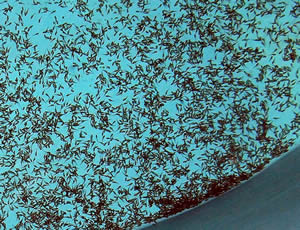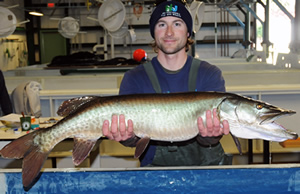Hackettstown State Fish Hatchery - 2014 Broodstock Collectionby Craig Lemon In late winter and early spring each year staff from the Hackettstown State Fish Hatchery venture to various north Jersey lakes and reservoirs to obtain broodstock for the Division's warmwater and coolwater stocking programs. These adult fish are netted, brought to the hatchery for spawning, and then returned to their water of origin. The 2014 spring trapnetting season seemed like it would never get here after the long, cold, icy, snowy winter. Looking back at the 18 year average, trapnets have been set for northern pike broodfish collection on or near March 10th. This year, hatchery staff would have had to cut through 12-15 inches of ice for that to happen! Mid-month came and went with little end in sight of getting nets in the water. Division Conservation Officer Shannon Martiak, whose patrol area covers the central part of the state, indicated anglers still ice fishing at Farrington Lake! With the days ticking away and anxiety/anticipation building, hatchery staff stayed in close contact with CO Martiak for the first signs of ice receding. Northern pike are a species known to actually spawn under the ice and as the weeks went by concern about that happening was building. Finally, on March 24th, Farrington Lake was completely open; Hackettstown staff immediately set 3 South Dakota-style trapnets. At the same time, biologists from the Bureau of Freshwater Fisheries set additional nets in Farrington Lake to sample the pike population as part of a larger statewide study. Despite these efforts, only 7 northern pike were captured from March 24 to March 28. Of the seven pike, 4 were males and 3 were females. The biggest female was 37.3 inches long and weighing 12.28 pounds. She was ripe with eggs and spawned back at the hatchery producing 57,000 eggs. The 57,000 eggs were a long way from the over 250,000 needed to meet the state's 2014 stocking needs. Staff checked the conditions at Budd Lake through the weekend of March 29-30; it remained completely frozen, but it was darkening up - a sure sign that it would break soon. A follow-up check Monday morning found the lake completely open; the ice had disappeared overnight.
In all 5 female northern pike produced 258,000 eggs in 2014 compared to 27 females that produced 880,000 eggs in 2013. Despite the low number of eggs taken, the hatchery had its highest percent hatch of all time at 71% and soon had 180,000 pike fry to start growing. Pike eggs hatch in 10 days, and the fry swimup looking to feed in another 5 days. Once hatched, northern pike grow fast! The pike are currently more than 5 inches in length and will be stocked in June when they reach their targeted size of 6-7 inches. After a rough start with northern pike, things turned around 180 degrees with walleyes. While still fishing nets in Budd Lake for northern pike and a weekend approaching, staff saw ideal spawning conditions with a warm snap coming over the next few days and scrambled on a Friday afternoon to get a PA-style trapnet strategically placed, cutting off the mouth of Neldon Brook in Swartswood Lake. After heavy spring runoff from ice and snow melting, and a recent heavy rainfall, the brook would be running full and attracting adult walleye in to spawn. What a great call that turned out to be. Early Saturday morning, April 5th, as the crew floated over the cage area of the trapnet and looked into the clear water all they could see were white tip tails and eyes. They struggled to lift the net onto the bow of the boat it was so full of walleye! Overnight, the net captured 244 walleyes, yielding over 800 pounds of fish!
Having captured record numbers of walleyes from Swartswood Lake and water temps rising toward the 50-degree mark, staff quickly switched gears once again and headed further north to Greenwood Lake knowing that muskies would be migrating into the shallow southern end of the lake to spawn. On April 10th, two Pennsylvania trapnets and a South Dakota trapnet were set near the mouth of Belcher's Creek. The nets were fished for 6 days and captured 35 muskies, the third highest number behind the 46 in 2009 and the 37 in 1999. The 20-year average muskie catch is 22 fish. The strategically placed nets captured 12 muskies on the first day, one third of the 7-day total. Unlike 2013, when the male to female catch ratio was 9 males to 20 females, the 2014 number was nearly split down the middle with 17 males and 16 females, with two fish being immature. The males averaged 11.1 pounds and 35.3 inches, ranging from 6.98 - 15 pounds and 31.5 - 38.7 inches. The females averaged 17.8 pounds and 41.9 inches and ranged from 12.64 - 22.7 pounds and 37.5 - 45.5 inches. Of the 16 females captured, 6 of them were spawned with male muskies yielding 388,640 purebred eggs, an average of 64,773 per female. Four of the other females were crossed with northern pike males, which yielded 261,815 tiger muskellunge eggs.
Overall, hatchery staff took 530,163 muskie eggs from 8 females, compared with 2,046,473 in 2013 from 24 females. This year's eggs hatched at 60%, one of the highest ever (compared to just 30% in 2013). Once hatched, the 315,000 fry fed off their yolk sacs for the first seven days. After their yolk sacs were absorbed, they began to free swim (swimup fry). This phase begins the toughest month at the hatchery as we work to convert a high percentage of these fry onto dry pelleted diets. This conversion period begins with rearing and feeding the 7-day old muskie fry brine shrimp every few hours, including the middle of the night, as the muskies respond more quickly to a moving feed source as opposed to the dry feed that drops straight down through the water column. The tiny fry are fed brine shrimp for 14 day, with more dry feed mixed in every day, weaning the fry off of the shrimp by the end of the two week period. As the fry are growing the feed particle size is increased every couple of days, as the fish seem to target the larger feed pellets as soon as they are introduced. This helps greatly in reducing cannibalism. By this time a good percentage (>80%) will have taken to the dry food diet. The muskie fry are raised both intensively indoors in hatchery tanks and more extensively outdoors in earthen ponds. The target is 12,000 ten-inch fingerlings. They should reach this size by October 15th in time to be float stocked into lakes, rivers and reservoirs.
All of these fish are provided at no charge to our neighbors and are part of an ongoing multi-state fish trade that has gone on for many years. Most of New Jersey's cool and warm water stocking programs started with eggs and fry supplied from Pennsylvania and New York hatcheries. New Jersey has been receiving 2,000 fingerling landlocked Atlantic salmon from the State of Massachusetts since 2006. State pathologists sample all of these fish before transport to insure they are free of disease. All adult muskies handled at the hatchery over the past seven years have been tagged with orange streamer tags inserted near the base of the dorsal fin. The tags bear the message "CALL HACKETTSTOWN HATCHERY (908) 852-4950" along with a tag number. Anglers who call in to report catching a tagged fish will be told when the fish was tagged, and its length and weight at the time of tagging. Reports of tagged fish provide the hatchery and state fisheries biologists with important growth information on the state's muskellunge, so please report your catch. In coordination with fisheries biologists from the Bureau of Freshwater Fisheries, the Hackettstown Hatchery is raising the following numbers of northern pike, muskellunge, tiger muskies, and walleyes to meet the state's needs for 2014:
24,520 northern pike fingerlings for stocking in: The Hackettstown State Fish Hatchery also raises 13 other species of fish for waters throughout the state - see the hatchery's production and stocking summaries for details. All fish raised at the Hackettstown Hatchery are stocked in public waters throughout the state to provide recreational fishing for licensed anglers and their families. The hatchery also raises several species of fish to assist the state's mosquito control efforts. The hatchery stocks 2-3 million fish annually. The Hackettstown Hatchery is supported entirely through the sale of fishing licenses and federal Sport Fish Restoration Program grant monies generated from the sale of fishing equipment. Below are summary tables of fish collected in spring, 2014. NORTHERN PIKE
MUSKELLUNGE
WALLEYE
|
|||||||||||||||||||||||||||||||||||||||||||||||||||||||||||
|
||
|
|
||
|
||

